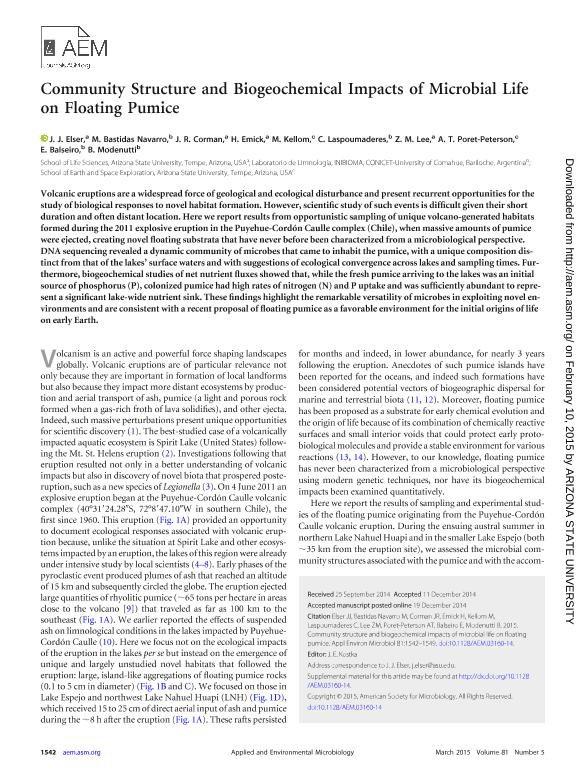Mostrar el registro sencillo del ítem
dc.contributor.author
Elser, James J.
dc.contributor.author
Bastidas Navarro, Marcela Alejandra

dc.contributor.author
Corman, Jessica R.
dc.contributor.author
Emik, Hillary
dc.contributor.author
Kellom, Matthew
dc.contributor.author
Laspoumaderes, Cecilia

dc.contributor.author
Lee, Zarraz M.
dc.contributor.author
Poret Peterson, Amisha
dc.contributor.author
Balseiro, Esteban Gabriel

dc.contributor.author
Modenutti, Beatriz Estela

dc.date.available
2018-03-21T19:59:23Z
dc.date.issued
2015-01
dc.identifier.citation
Elser, James J.; Bastidas Navarro, Marcela Alejandra; Corman, Jessica R.; Emik, Hillary; Kellom, Matthew; et al.; Community structure and biogeochemical impacts of microbial life on floating pumice; American Society for Microbiology; Applied And Environmental Microbiology; 81; 5; 1-2015; 1542-1549
dc.identifier.issn
0099-2240
dc.identifier.uri
http://hdl.handle.net/11336/39558
dc.description.abstract
Volcanic eruptions are a widespread force of geological and ecological disturbance and present recurrent opportunities for the study of biological responses to novel habitat formation. However, scientific study of such events is difficult given their short duration and often distant location. Here we report results from opportunistic sampling of unique volcano-generated habitats formed during the 2011 explosive eruption in the Puyehue-Cordón Caulle complex (Chile), when massive amounts of pumice were ejected, creating novel floating substrata that have never before been characterized from a microbiological perspective. DNA sequencing revealed a dynamic community of microbes that came to inhabit the pumice, with a unique composition distinct from that of the lakes' surface waters and with suggestions of ecological convergence across lakes and sampling times. Furthermore, biogeochemical studies of net nutrient fluxes showed that, while the fresh pumice arriving to the lakes was an initial source of phosphorus (P), colonized pumice had high rates of nitrogen (N) and P uptake and was sufficiently abundant to represent a significant lake-wide nutrient sink. These findings highlight the remarkable versatility of microbes in exploiting novel environments and are consistent with a recent proposal of floating pumice as a favorable environment for the initial origins of life on early Earth.
dc.format
application/pdf
dc.language.iso
eng
dc.publisher
American Society for Microbiology

dc.rights
info:eu-repo/semantics/openAccess
dc.rights.uri
https://creativecommons.org/licenses/by-nc-sa/2.5/ar/
dc.subject
Pumice
dc.subject
Diversity
dc.subject
Nitrogen
dc.subject
Phosphorus
dc.subject
Lake
dc.subject
Patagonia
dc.subject.classification
Otras Ciencias Biológicas

dc.subject.classification
Ciencias Biológicas

dc.subject.classification
CIENCIAS NATURALES Y EXACTAS

dc.title
Community structure and biogeochemical impacts of microbial life on floating pumice
dc.type
info:eu-repo/semantics/article
dc.type
info:ar-repo/semantics/artículo
dc.type
info:eu-repo/semantics/publishedVersion
dc.date.updated
2018-03-02T14:24:36Z
dc.journal.volume
81
dc.journal.number
5
dc.journal.pagination
1542-1549
dc.journal.pais
Estados Unidos

dc.journal.ciudad
Washington
dc.description.fil
Fil: Elser, James J.. Arizona State University; Estados Unidos
dc.description.fil
Fil: Bastidas Navarro, Marcela Alejandra. Consejo Nacional de Investigaciones Científicas y Técnicas. Centro Científico Tecnológico Conicet - Patagonia Norte. Instituto de Investigaciones en Biodiversidad y Medioambiente. Universidad Nacional del Comahue. Centro Regional Universidad Bariloche. Instituto de Investigaciones en Biodiversidad y Medioambiente; Argentina
dc.description.fil
Fil: Corman, Jessica R.. Arizona State University; Estados Unidos
dc.description.fil
Fil: Emik, Hillary. Arizona State University; Estados Unidos
dc.description.fil
Fil: Kellom, Matthew. Arizona State University; Estados Unidos
dc.description.fil
Fil: Laspoumaderes, Cecilia. Consejo Nacional de Investigaciones Científicas y Técnicas. Centro Científico Tecnológico Conicet - Patagonia Norte. Instituto de Investigaciones en Biodiversidad y Medioambiente. Universidad Nacional del Comahue. Centro Regional Universidad Bariloche. Instituto de Investigaciones en Biodiversidad y Medioambiente; Argentina
dc.description.fil
Fil: Lee, Zarraz M.. Arizona State University; Estados Unidos
dc.description.fil
Fil: Poret Peterson, Amisha. Arizona State University; Estados Unidos
dc.description.fil
Fil: Balseiro, Esteban Gabriel. Consejo Nacional de Investigaciones Científicas y Técnicas. Centro Científico Tecnológico Conicet - Patagonia Norte. Instituto de Investigaciones en Biodiversidad y Medioambiente. Universidad Nacional del Comahue. Centro Regional Universidad Bariloche. Instituto de Investigaciones en Biodiversidad y Medioambiente; Argentina
dc.description.fil
Fil: Modenutti, Beatriz Estela. Consejo Nacional de Investigaciones Científicas y Técnicas. Centro Científico Tecnológico Conicet - Patagonia Norte. Instituto de Investigaciones en Biodiversidad y Medioambiente. Universidad Nacional del Comahue. Centro Regional Universidad Bariloche. Instituto de Investigaciones en Biodiversidad y Medioambiente; Argentina
dc.journal.title
Applied And Environmental Microbiology

dc.relation.alternativeid
info:eu-repo/semantics/altIdentifier/url/http://aem.asm.org/content/81/5/1542
dc.relation.alternativeid
info:eu-repo/semantics/altIdentifier/doi/http://dx.doi.org/10.1128/AEM.03160-14
Archivos asociados
